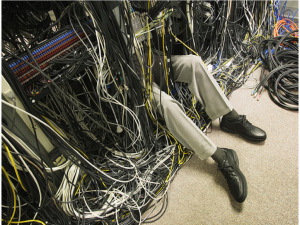Extend Your Data Center’s Life Cycle
With the steep rise in energy costs, data center operators and their clients are recognizing energy efficiency as key for future growth. Managing a data center’s hardware life cycle is an ongoing process and needs to be constantly updated. Costly failure rates and downtime can be avoided by identifying and isolating hotspots and inefficient devices prior to implementation and equipment upgrades. Introducing cooling simulation early in your design process can reduce your data center cooling costs.
A typical server service life is about three to five years, but that number can now be as long as eight years. Some data centers are so impoverished that servers must run even longer than that. Machines require increased maintenance as they wear down. But this increases data center costs. So the  question is, how can data center engineers extend the life of their machines while keeping everything cost effective?
question is, how can data center engineers extend the life of their machines while keeping everything cost effective?
The methods to extend the life cycle of the data center would be as follows:
- It is much needed to make sure we get the most from existing technology. We need to take advantage of the best practices such as proper room sealing, the hot-aisle/cold-aisle rack arrangement, and preventive maintenance to optimize the performance of the existing data center cooling system. Installation of a supplemental cooling infrastructure is the next step. This would indeed extend the facility life and delay the need to build a new data center.
- Using the right size building blocks is essential, as the input power to the facility will ultimately determine how much equipment can be supported. As an example, by analyzing the power system reliability of a multi- module UPS configuration, it is recommended that the UPS modules be sized no less than one-third of the total facility load.
- Older machines require extra care because with older hardware, the little things can make all the difference. To help the system run longer, several tasks need to be completed at least once a month. For example, make sure that all operating system patches, updates, drivers and roll ups have been deployed; the antivirus system has been updated and is operational. Now with better technology and resources, this can be accomplished more easily and cost-effectively than ever.
- It is quite tricky to predict what technologies a data center may have to support in the next 10 years. The best approach would be to employ adaptive technologies that would give us the most flexibility to respond to change. Though availability is still the No. 1 factor in infrastructure design, flexibility is now a close second.
- If a server uses local storage, run the Disk Cleanup as well as Defragment tool to help the machine run longer with stable data and a cleaner running drive. Running hard drive health checks on a regular basis, regular inspection of hardware components within the machine and making sure all fans are operational and verify that all components and cable headers are in their place is very essential. There is also a need to keep an eye on dust buildup as this can quickly interrupt cooling and cause electrical glitches that can affect the server.
- To provide valuable intelligence and control at both the rack and room level, the monitoring systems have improved beyond simple alarming. Intelligent controls in computer room air conditioners now enable multiple units in a room to work together as a team, increasing system efficiency. Intelligent power strips provide receptacle-level visibility and control of equipment power on the rack level.
- It is necessary to stay vigilant. The past experiences have shown that the equipment with a robust maintenance program experience reduced downtime and clearly extend the life of their data center equipment. Also, consider regular data center assessments to monitor the impact of new technology and ensure supporting technologies and best practices are current.
Optimization of the electrical and physical environment will assist any server work for a longer duration. This includes the following important factors: electricity, temperature and air quality:
- Electricity quality plays a key role in determining the longevity of a machine. To maintain healthy operation of the machines, managing the amount of voltage entering the server room is very critical. A sudden spike can severely damage computers. Using a good uninterruptible power supply and power regulators will help to monitor the amount of input voltage to the machine, or a rack of servers.
- The room temperatures for normal operation of most servers should be between 60 to 85 degrees Fahrenheit. A steady humidity level between 50 and 75 percent should be maintained. Proper management of the environment in a data center would increase performance of the machines inside and also allows them to have longer operational life.
- Air quality is also very important with computers as proper air circulation could prevent its overheating. It is much needed to keep good airflow around your machines. Servers need to be moved away from walls to allow vents to properly circulate hot and cold air.
Data Center Talk updates its resources every day. Visit us to know of the latest technology and standards from the data center world.
Please leave your views and comments on DCT Forum
